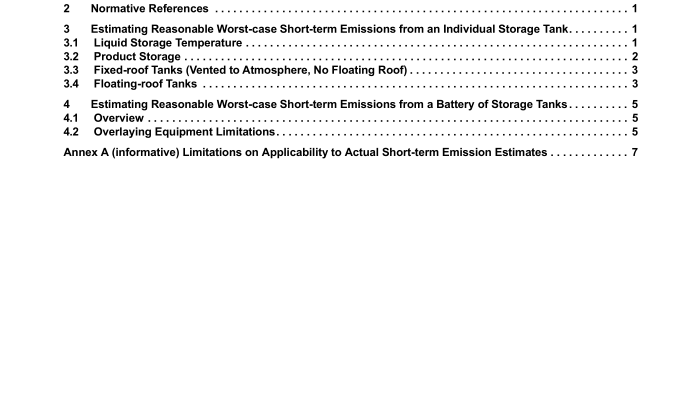API TR 2576:2016 pdf free download.Short-term Evaporative Loss Estimation from Atmospheric Storage Tanks
3.2 Product Storage
The chemical properties of the product stored in the tanks are the primary parameters used to estimate emissions from a tank. For tanks that can store multiple products throughout the year, emissions should be calculated for each product. In some states, it is accepted practice to use the highest-emitting product or hazardous air pollutant (HAP) combined with a Protective Action Criteria (PAC) 3 threshold or Effects Screening Level (ESL) 4 to be representative of worst-case hourly emissions. As an example, for the same tank configuration, same throughput, same location, and same season, gasoline with a Reid Vapor Pressure (RVP) of 12 psi will most often represent a worst case relative to gasoline stored with an RVP of 9 psi, assuming HAP contents are the same. If for the same scenario the HAP content of the RVP 9 psi gasoline were significantly higher than the RVP 12 psi gasoline, then the RVP 9 psi gasoline may be a worst case based on a particular HAP or chemical properties. Chemical parameters obtained from actual product measurements are preferred over more generic properties representing a broadly defined class of products.
3.3 Fixed-roof
Tanks (Vented to Atmosphere, No Floating Roof) The maximum short-term emission rate, L MAX , is to be determined using the working loss, L W , which is calculated with the throughput based on the maximum filling rate and with the turnover (saturation) factor, K N , set equal to 1. The liquid surface temperature is to be set using the liquid surface temperature equation in 3.1. An annual working loss, L W , can then be determined from API MPMS Ch. 19.1 equations. If the tank stores different stocks during the course of a year, then each stock should be evaluated separately. Given that the working loss would typically be the dominant mechanism driving short-term emission rates for fixed-roof tanks, the calculation of short-term emission rates for typically controlled fixed-roof tanks without vapor recovery may be based on only the working loss. (i.e. the standing loss may be neglected).
Follow the following steps.
Step 1: Use API MPMS Ch. 19.1, Section 4.3.1, Equation (21) 5 to calculate annual working loss, L W , with:
— throughput calculated from the maximum filling rate,
— the turnover (saturation) factor, K N , set to 1.0,
— the product factor, Kc, for crude oil stocks is set to 1.0, and
— the liquid surface temperature determined from 3.1 of this document.
Step 2: Divide this annual working loss by 8760 hr/yr to obtain the maximum short-term emission rate, L MAX .
3.4 Floating-roof Tanks
3.4.1 Overview
For floating-roof tanks, the type of floating-roof construction, including all deck fitting data, has to be known in order to accurately estimate emissions.
The short-term emission rate for floating-roof tanks is based on the highest monthly average emission rate for standing loss coupled with the maximum pumping rate for working loss. If the tank stores different stocks during the course of a year, then each stock should be evaluated separately for the portion of the year it is stored (e.g. summer and winter gasoline).
Working loss for a floating-roof tank occurs as liquid is being pumped out of the tank, thereby lowering the liquid level and leaving behind a wetted tank shell. Working loss occurs as a result of evaporation of this liquid film that is left behind, and it is sometimes called withdrawal or clingage loss. Working losses would typically not dominate short- term emission rates for floating-roof tanks, and therefore short-term emission rates for floating-roof tanks shall be based on both standing and working loss.
The total maximum short-term emission rate, L MAX , is then the sum of the maximum short-term working loss, L WD , and the maximum short-term standing loss, L S . The maximum short-term standing loss, L S , is the sum of the rim seal, deck fittings, and deck seam losses. The procedure for calculating the total maximum short-term emission rate is slightly different for external floating-roof tanks than for internal floating-roof tanks and domed external floating-roof tanks.API TR 2576 pdf downloadAPI TR 2576:2016 pdf free download
